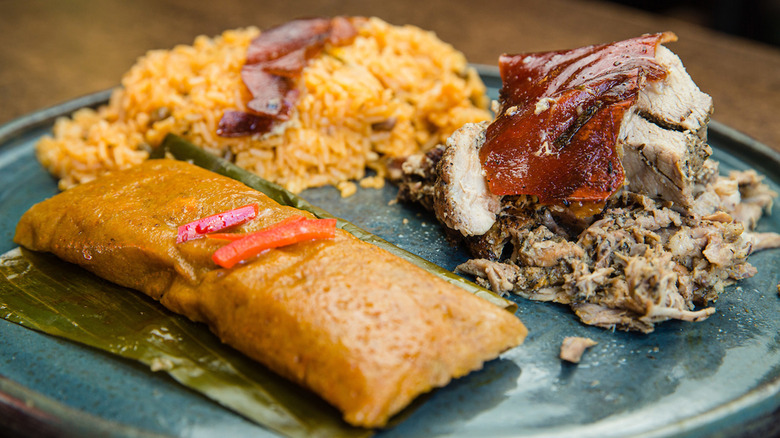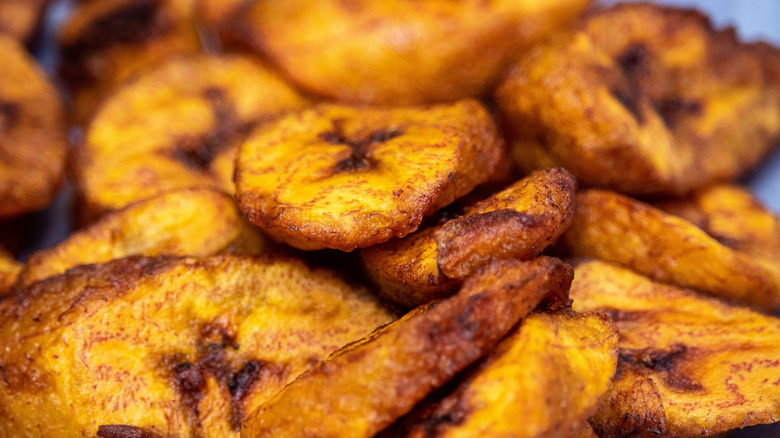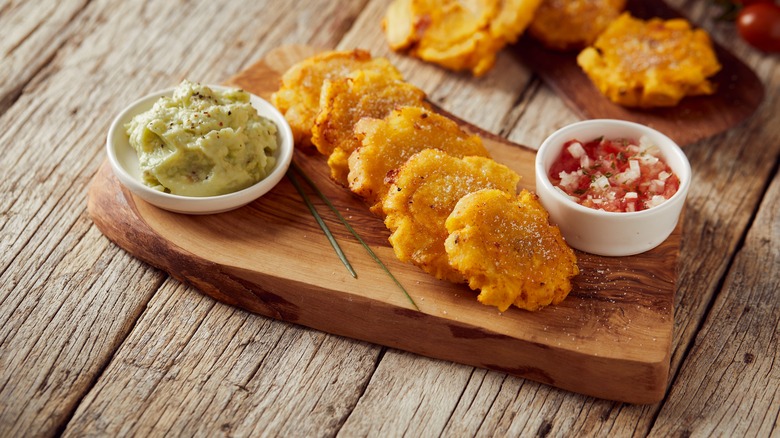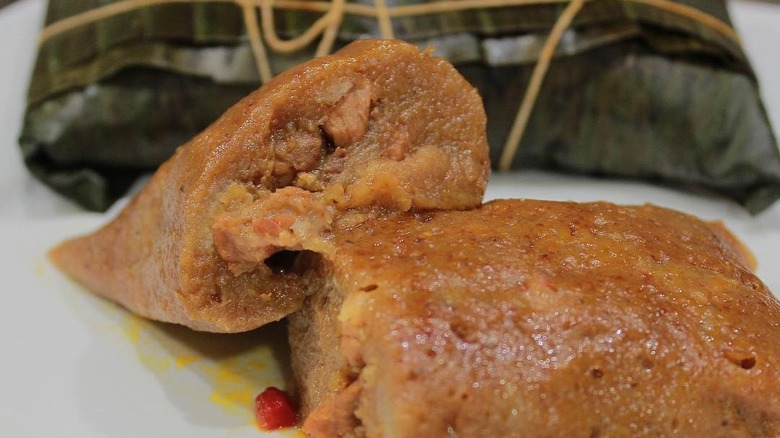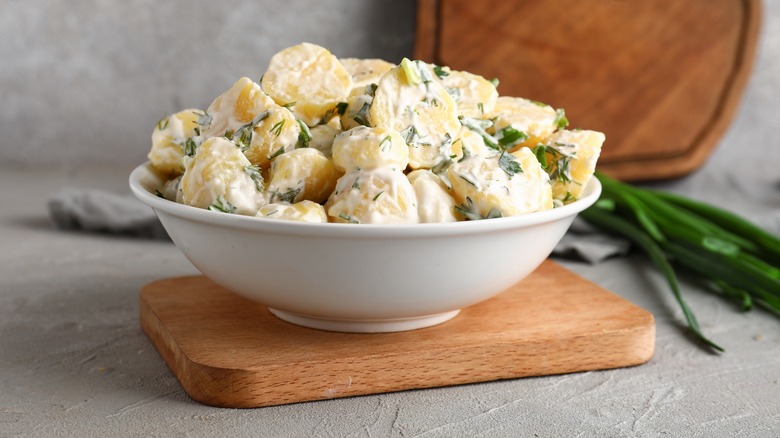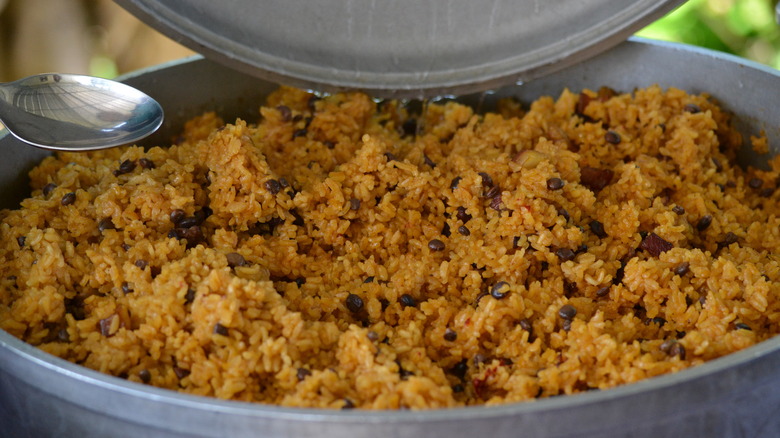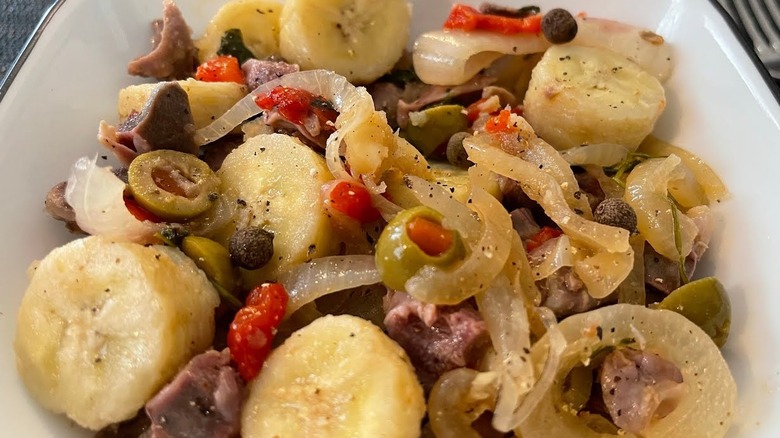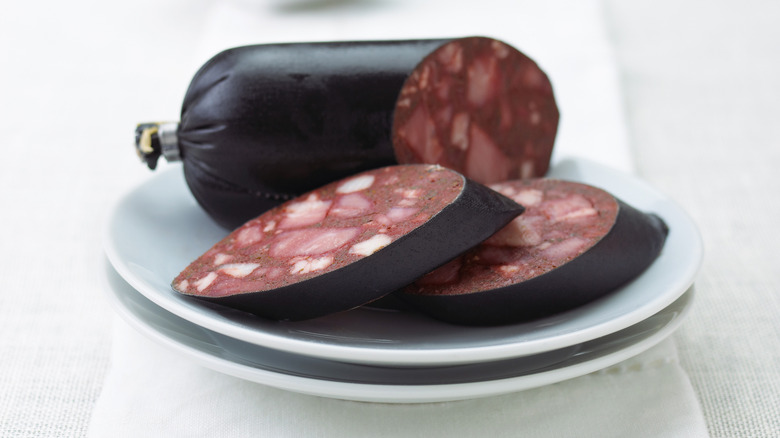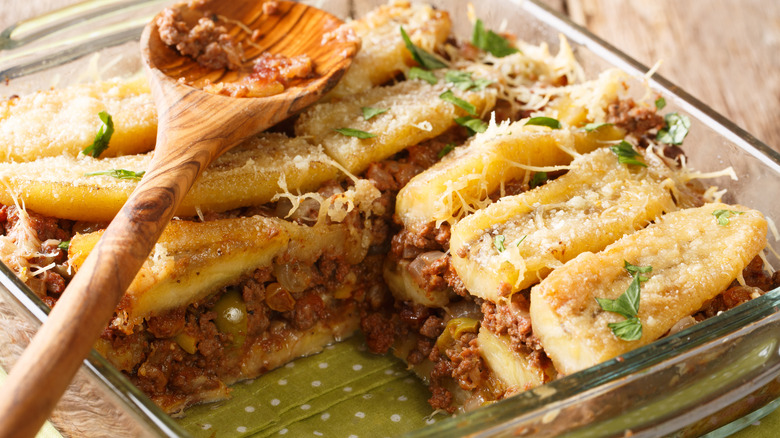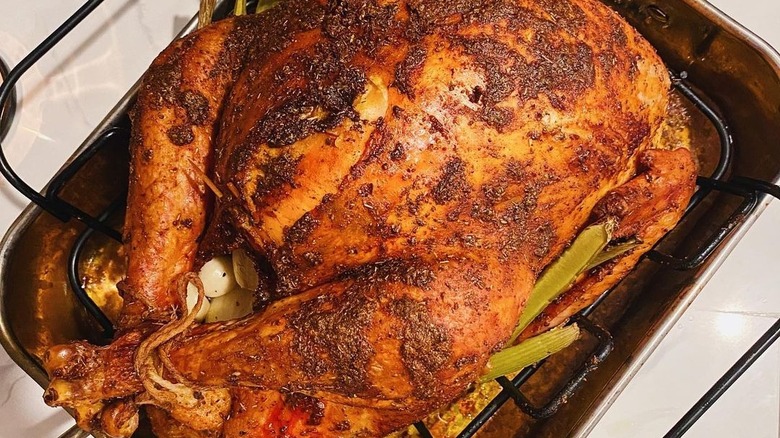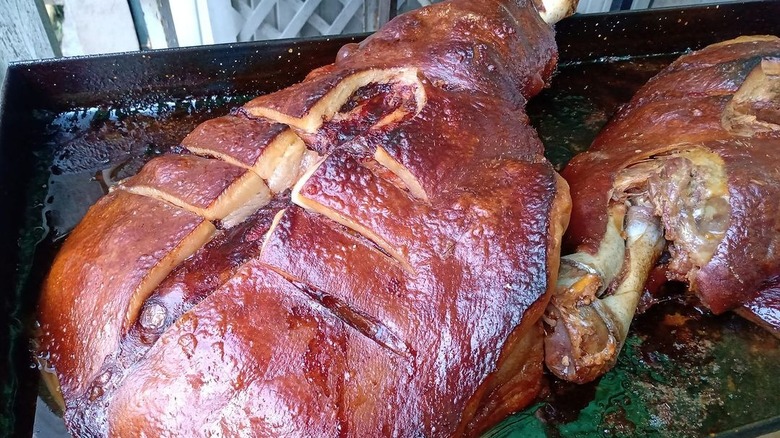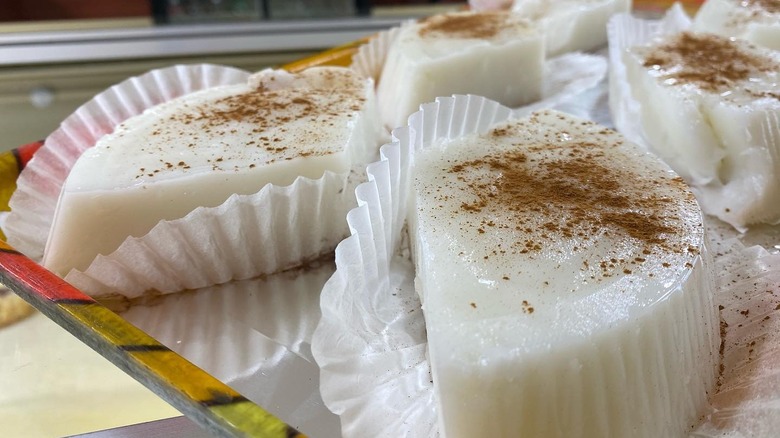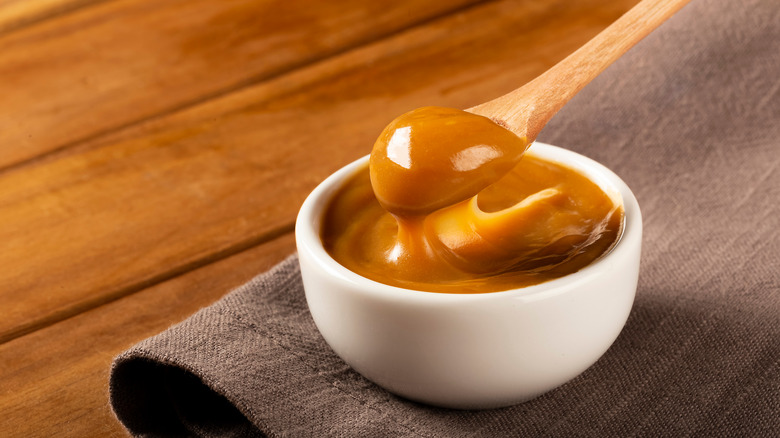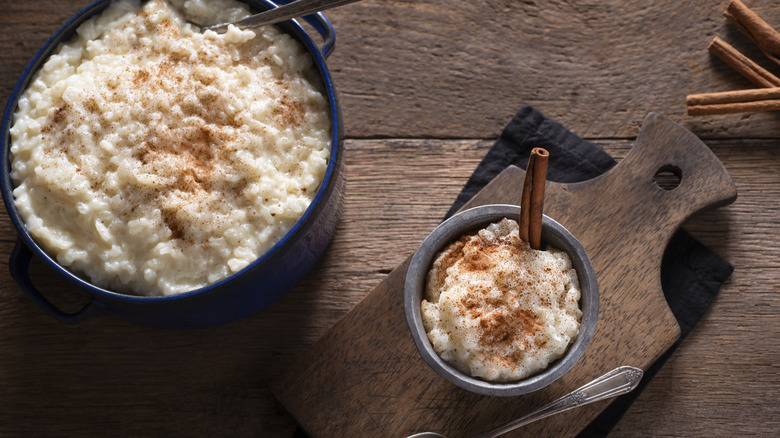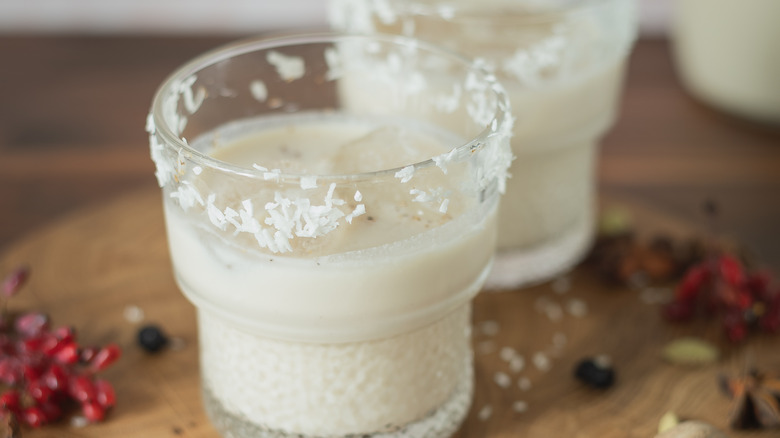15 Dishes That Define Thanksgiving In Puerto Rico
Thanksgiving is a celebration of gratitude for life and those that mean the most to us. It's also a day of mountainous plates loaded with delicious, sometimes sleep-inducing, food. From savory stuffing to mouth-salivating mac n' cheese, according to Statista, Thanksgiving is one of America's most popular national holidays. Fun fact: There's more food consumed on Thanksgiving than any other day — the second place is held by Super Bowl Sunday, per the USDA. Its popularity is no surprise, after all, what greater pleasure is there than spending time with loved ones over a seasonal spread?
Food and family aren't exclusive to America, so as it happens, Thanksgiving has grown beyond the states and today is celebrated in Canada, Germany, Liberia, Japan, The Netherlands, Norfolk Island, Grenada, and Puerto Rico. While each country has distinct celebratory roots, they all observe the most important aspect: gratitude. Thanksgiving dinner is different in other places, too. After becoming an unincorporated U.S. territory in 1898, Puerto Rico adopted Thanksgiving and even chose to celebrate it on the same day. That's where the similarities pretty much end, though, as Puerto Rico's Thanksgiving dinner looks vastly different than the rest of the U.S.'s.
Beyond American cuisine, it includes indigenous Taíno, Spanish, African, and other cultures. Rather than bread stuffing, turkeys are stuffed with a mashed plantain dish called mofongo. For dessert, tembleque replaces pumpkin pie. If you've grown tired of traditional gobble-gobble go-tos, switch things up and try some dishes that define Thanksgiving in Puerto Rico.
Amarillos
What looks like a banana, can be found at the store next to bananas, but has its own unique flavor and consistency? Plantains are a staple ingredient in Puerto Rican cuisine. From plantain fries to mash, it's a versatile food that's enjoyed savory and sweet. One popular way to consume it is sliced, sweetened, and fried. Called amarillos and also maduros, fried sweet plantains are perfect appetizers for quelling impatient hunger pangs on Thanksgiving. Amarillos are commonly enjoyed as a snack and for dessert, too.
Rather than green unripe plantains, super ripe ones are used for their natural sweetness and are sometimes dipped in cinnamon and sugar. It helps balance out savory dishes without overwhelming your sweet tooth like those made specifically for dessert. When cooked, the starch caramelizes into sugar, developing a fried exterior and moist consistency. The best part is that fried plantains are easy to make. Picking ripe plantains is the most important step — look out for the yellow ones transitioning to black.
Tostones
Tostones are another popular way to fry plantains in Puerto Rico. Beyond the cooking process, they are a completely distinct plantain experience. Tostones are unique because they are made from unripe green plantains and rather than a simple slice and fry, they are sliced thinner and twice-fried. Crispy and tasty, tostones are a staple food found in many South American cuisines — they are also popularly referred to as "patacones." Amarillos and tostones do have another thing in common; they are both easy to cook.
After you've procured unripe green plantains, you first need to peel them. Unlike bananas, peeling an unripe plantain can be a challenge for beginners. You start by removing both ends, followed by a single slice on either side lengthwise, cutting the skin while making sure not to touch the flesh. Next, carefully peel the skin and scrape away any remaining skin residue. Tostones develop a delicious crunchy consistency when fried because they are thinner than amarillos. You want to cook them until they are nice and golden brown.
Pasteles
If you're a fan of Mexican tamales, you'll undoubtedly love unraveling Puerto Rican pasteles. "Pastel" is Spanish for "cake" and "pie," but this special culinary creation is far from either. Like tamales, pasteles are wrapped, but rather than using corn husk, they are steamed in a banana leaf that's filled with a pork and masa mixture. Seasoned and savory, Puerto Rican masa consists of green plantains, and root vegetables, and the pork filling includes sofrito, vinegar, capers, and sazòn. It's definitely one popular Puerto Rican food you have to try, and it's a great way to put a new spin on your traditional Thanksgiving menu.
During the holiday season, locals have large pastele-making gatherings. Families come together to help prepare pasteles and different members handle different parts of the process assembly line-style. It's primarily enjoyed on Christmas because the wrapped pastele is reminiscent of a present, but the extensive preparation creates a sense of togetherness, which is an integral part of celebrating Thanksgiving. Who knows, maybe you can convince the fam to help you prepare pasteles for the holiday. The work is absolutely worth the delicious bite.
Ensalada de papa
Potato salad and family gatherings go together like hot dogs and sporting events. It is a comfort classic that is equally tasty as it is filling. In Puerto Rico, potato salad is called "ensalada de papa," and although it mostly includes the same ingredients, it also features a special fruity addition: apples. That means it is not only creamy and tangy but sweet as well. Apples add a refreshing crisp to the flavor profile, breaking up the monotony of mayo and adding a much-appreciated crunch.
During the holidays, it is typically served as a side or for dessert. As a side, it pairs great with all of the Thanksgiving classics you know and love. Not only will it cause quite a stir at the dinner table if it's not in your usual holiday lineup, but it's also a great way to inject some fun into the holiday season.
Arroz con gandules
Rice and beans are not only an integral part of South American cuisine, it's a classic combo worldwide. You simply can't go wrong with affordable ingredients that are healthy and hearty. In Puerto Rico, during the holidays and year-round, arroz con gandules is the rice and bean dish of choice. It's so popular that many consider it the country's national dish. Humble yet crave-worthy, arroz con gandules is made with rice, beans, and Puerto Rican sofrito (cilantro, culantro leaves, aji dulce peppers, and annatto seeds). Sofrito is commonly used as a flavor base for local dishes.
Gandules, also known as pigeon peas, is a legume that originates from India. They are less available in the U.S. but can be substituted with pinto, red kidney, or black beans and still be just as tasty. Pork and green olives are also frequently added to arroz con gandules, giving it an extra savory kick. We definitely recommend pulling this dish out for Thanksgiving, it may end up becoming a permanent flavorful fixture.
Guineos con mollejas en escabeche
This next Puerto Rican holiday staple is one of those "everything but the kitchen sink" type of dishes. Guineos con mollejas en escabeche, which translates to bananas with pickled gizzards, is a meat-heavy meal served chilled and enjoyed as a side or with grilled meats or seafood. It's composed of unripe green bananas and chicken gizzards that are marinated in a smorgasbord of ingredients that range from bell peppers and bay leaves to olive oil and vinegar. This is a dish for real meat lovers; the chewy consistency of cold chicken gizzards is an acquired one. In actuality, it's a derivative of the gizzard-less original, guineos en escabeche.
That said, the gizzards can also be swapped for shrimp or other parts of the chicken. Green bananas, which have a potato-like taste and consistency, help balance the overall texture profile. Guineos con mollejas has a piquant pickled taste with herbaceous and aromatic accents. It's most commonly served cold or room temperature with rice and avocado, but can also be served hot.
Morcilla
Another popular meaty go-to during Puerto Rico's holiday season is morcilla, otherwise known as blood sausage. It's a dish that's enjoyed year-round but is especially eaten during the holidays. Carrying a deep black color, morcilla is a unique sausage that comes from Spain. It gets its robust flavor and meaty density from fresh pig's blood, seasoning, onions, ground pork, and rice that's stuffed into a casing made of pig intestine. In Puerto Rico, morcilla also includes cilantro and chili peppers, which give it a touch of spicy zest.
Perfect for large gatherings, locals primarily eat it as part of the main spread during Thanksgiving, yet throughout the year will pair it with boiled green bananas or tostones. In the States you'll most likely have to visit your grocery store's deli counter or a local butchery, as blood sausage is a special variety. Its unique color will certainly spark conversation around the dinner table.
Pastelón
From amarillos to tostones, the versatility of plantains appears in many forms in Puerto Rican cuisine. Whereas those treats are fried, pastelón is a casserole that's made with layers of sliced plantains filled with picadillo, which is a mixture of ground beef, peppers, onions, egg yolk for binding, and seasonings commonly used in cuisines throughout South America. Pastalón is sort of like an interesting twist on lasagna that tastes sweet, savory, aromatic, and totally worth a second helping.
Different countries in South America make their own variations of it; the Dominican Republic is especially fond of it, and like Puerto Rico, prepares it during the holiday season. Pastelón requires a little more prep work than lasagna but can be baked in under 30 minutes. It's the perfect Thanksgiving recipe that highlights Puerto Rico's love for banana's sweet-less sibling. You can also take things up a notch and add a garnish of cheese. What are you waiting for? Save it to your holiday recipe list and prepare to wow family members.
Pavochón
Like in America, turkey is also the centerpiece of Puerto Rican Thanksgiving. There, it's called pavochón and is prepared in a style unique to the country. The word pavochón is actually a combination of two Spanish words: pavo, which means turkey, and lechon, which translates to piglet. It's a meaty delight that's roasted pork-style, or as it's called locally, pernil. Pavochón is a flavorful punch of garlic, oregano, black pepper, olive oil, sazón, adobo, and vinegar that's mashed into a paste, massaged into the turkey, and left to marinate overnight.
Deliciously tender, the mouthwatering meat is only part of what makes pavochón the highlight of the holiday, Puerto Rican-style stuffing elevates flavor further. Rather than bread, it's made with mofongo, which is mashed fried green plantains mixed with broth, chicharrones, bacon strips, and fresh garlic. Pork rinds provide a crispy consistency that complements the roasted taste of turkey. It's then combined with sofrito to make the stuffing. Trust us, this is a game-changing recipe that you'll wish you had learned a long time ago.
Pernil
For pavochón to be cooked in the same style that pork is roasted, pernil has to pack a memorable taste. Slow-cooked for maximum lip-smacking tenderness, pernil is Puerto Rico's version of roasted pork. It's popular during the holiday season and like many Thanksgiving staples, requires a good amount of preparation — you'll need at least 45 minutes per pound of pig. Taking a low-and-slow approach is how you coax out the pork's flavorful potential.
The thing that makes pernil unique is how it's prepared. In Puerto Rico, it is marinated overnight in an aromatic blend of sofrito and a seasoning blend of garlic, sazón, paprika, onion powder, oregano, cumin, garlic powder, chili powder, salt, and pepper. It's a labor of love that's totally worth waiting until the next day for. Pernil also makes some of the best leftovers, that is of course, if the family doesn't eat it all on Thanksgiving.
Mofongo stuffing
If there's one dish that Puerto Rico is known for, it's mofongo. Considered the country's unofficial national dish, it's a celebratory meal that can be served as a main course but is typically paired with a bowl of chicken broth. Mofongo is a mashup of green plantains, garlic oil, cilantro, and fried pork rinds, referred to by locals as chicharrónes. It's made using a pilón, which is a small wooden bowl that works like a mortar and pestle. A versatile culinary creation, mofongo has somewhat of a neutral taste that makes it perfect for pairing with more robust ingredients — its subtle savoriness is comparable to tamales.
Beyond chicken broth, mofongo goes great with rice and beans, any of your favorite meats, and even as a hearty stuffing for pavochón on Thanksgiving. Making mofongo stuffing is easy too, all you need to do is prepare a sofrito and blend the two together.
Tembleque
Dessert is a big part of any major national holiday and Puerto Rico's Thanksgiving celebration is no different. There, sweet tooths aren't satisfied by pumpkin or apple pies, but rather, by a tasty coconut pudding called tembleque. Name aside, it's not the creamy pudding pools that you are used to dipping your spoon in, it actually has a consistency similar to Jell-O. Like jelly, it shakes, which is funny because that's what "temblor" means in Spanish. Tembleque is a super simple 20-minute recipe made from sugar, cornstarch, ground cinnamon, salt, coconut milk, vanilla extract, and lime.
To bring your dessert dreams to life, all you have to do is cook the ingredients in a saucepan until the starch gelatinizes. It's a dairy-free and vegan-friendly dessert that tastes like sweet coconut and vanilla, with a cinnamon kick and a touch of lime. It's also the perfect way to follow up on a delicious Thanksgiving dinner.
Dulce de leche
Dripping with delicious sweetness, dulce de leche is a decadent deluge of saccharine satisfaction. As fancy as the name sounds, it's simply sweetened condensed milk reduced to a makeshift caramel sauce. For such a simple recipe, it's easily one of the tastiest toppings for fruits and desserts. Beyond Puerto Rico, it's a popular dessert option throughout South America, where in some places it's referred to by other names. Dulce de leche is a thick, creamy, gooey, and sweet must-have no matter what name you call it. Use it on everything from toast and fruit to bread pudding, frosting, atop ice cream, crepes, and the list goes on.
One caveat that may cause a pause is the two to three hours of cooking time it requires. Don't let that stop you though, because dulce de leche is absolutely worth the wait. The longer the simmer, the richer, more delectable the caramel.
Arroz con leche
From umami-rich meals to sugary-sweet desserts, there's a good reason why rice is one of the world's staple foods. It's a neutral playground for whatever your culinary imagination dreams. In countries around the world, rice is used to make all sorts of tasty treats. One Spanish dessert you need to try is the iconic arroz con leche. From its place of origin, it traveled to South America, where it's enjoyed during the holiday season as a celebratory treat. Arroz con leche is a traditional rice pudding dish made with sweetened condensed milk, cinnamon, and sometimes lemon or orange citrus peels.
Humble yet delicious, it has a creamy consistency and milky cinnamon taste. Its simplicity also allows for customization, as some recipes include fruits, nuts, chocolate, and even espresso. For large family gatherings like Thanksgiving, arroz con leche is a quick and easy recipe sure to bring smiles around the dinner table.
Coquito
In America, the holiday season doesn't feel as season-y without a cup of creamy egg nog. Puerto Rico's version of the wintery classic is called coquito. As if the name wasn't cute enough, coquito translates to "little coconut" in Spanish. Creamy, chilled, with a tropical touch, it's a rich-flavored beverage that might just give egg nog a runny for its money. Unlike our holiday go-to, coquito doesn't use eggs and it already includes alcohol.
That means that you don't have to sneakily spike your beverage while the family isn't looking. It's traditionally made with Puerto Rican rum, condensed or evaporated milk, cream of coconut, vanilla, and aromatic seasonal spices like cinnamon, nutmeg, vanilla, and ground clove. In Puerto Rico, it's synonymous with Christmas, but also popularly enjoyed on Thanksgiving. Locals typically drink it from a shot glass, with a meal, or as dessert. We definitely suggest swapping this year's egg nog with coquito.
